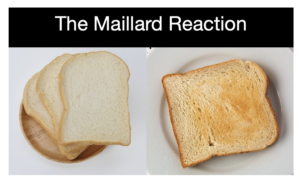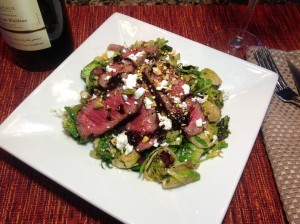 Have you ever wondered why veggies taste so good when they are roasted?
Have you ever wondered why veggies taste so good when they are roasted?
Or why bread smells so good when it is baking?
And, “what’s the point of searing a roast before you put it in the slow cooker?”
There is a reason for all of this…it’s a chemical reaction called:
Maillard Reaction
(pronounced “my-yard” by some and “me-yar” by others).
 This reaction was initially described by a French chemist, Louis Maillard, in the early 1900s. Without getting too scientific, this reaction has to do with how proteins (amino acids) and sugars in certain foods react when heated. What starts as a simple reaction becomes very complex, as other reactions are triggered and hundreds of molecules are created.
This reaction was initially described by a French chemist, Louis Maillard, in the early 1900s. Without getting too scientific, this reaction has to do with how proteins (amino acids) and sugars in certain foods react when heated. What starts as a simple reaction becomes very complex, as other reactions are triggered and hundreds of molecules are created.
These reactions not only change the color of your food (browning), but also create some truly amazing aromas and flavors!
A super simple example is toast. When you pull your bread out of the toaster, the flavor, color and aromas have changed – that’s the Maillard reaction at work! Why does your steak taste and smell so good when seared at high heat, forming a tasty crust on the outside without overcooking the inside? Yes, you achieved a Maillard reaction.
Other examples include roasted and sautéed vegetables, roasted coffee beans, baked breads, grilled or pan-fried fish and even black garlic. Even beer, chocolate and maple syrup experience the Maillard reaction when they are produced, contributing to their unique flavors and aromas.
Why is it important?
Understanding this reaction is a gateway to understanding how to make it work in your cooking which can help you become a more confident cook and help you produce absolutely delicious results!
This reaction begins at temperatures of 280 degrees or more. The higher the temperature, the more intense the reaction will be. Also, less moisture will produce a more intense reaction. That’s why it is important to pat your meat and vegetables dry before cooking. If they are wet, it is more difficult to get the temperature high enough for the reaction to occur. That is why you typically can’t achieve the reaction – and the resulting flavors and aromas – when boiling or steaming your foods.
What’s the difference between caramelization and the Maillard reaction?
To keep it simple, caramelization typically occurs when primarily sugars are present…resulting in a sweet, nutty flavor. When a protein is present, the Maillard reaction occurs. Typically, the flavors produced by the Maillard reaction are much more complex and diverse compare to caramelization. With some foods, caramelization and the Maillard reaction can occur simultaneously — this distinction isn’t really that important for most of us — the key is the wonderful flavors and aromas that result!
Is it safe?
 Studies have shown this reaction generates compounds that are beneficial to health as well as some that are potentially detrimental to health. In certain cases, it can lead to the formation of acrylamide in food, a compound which is has been classified as a probable human carcinogen.
Studies have shown this reaction generates compounds that are beneficial to health as well as some that are potentially detrimental to health. In certain cases, it can lead to the formation of acrylamide in food, a compound which is has been classified as a probable human carcinogen.
Fried and processed starchy foods are the most likely to contain acrylamide (things like french fries, potato chips, cereals, crackers and cookies). This is just one more reason to limit – or avoid – these foods.
To detoxify your body from any acrylamide you do consume, it has been shown that a healthy diet (seven or more servings a day) of antioxidant-rich fruit and vegetables, specifically cruciferous vegetables daily, can help do the trick.
There is more information from the FDA on acrylamide. Even the FDA advises consumers to “adopt a healthy eating plan, consistent with the Dietary Guidelines for Americans, that emphasizes fruits, vegetables, whole grains, and fat-free or low-fat milk and milk products; includes lean meats, poultry, fish, beans, eggs, and nuts; and limits saturated fats, trans fats, cholesterol, salt (sodium) and added sugars.” In other words, EAT REAL FOOD!
 So, now you can impress your family, friends and coworkers with this newfound knowledge!
So, now you can impress your family, friends and coworkers with this newfound knowledge!
And, in the next few weeks, we will provide a coaching tip on how to cook the perfect steak…while taking advantage of the Maillard Reaction’s flavors and aromas. Just in time to impress that special someone on Valentine’s Day!
As always, remember to…
…keep it simple and EAT REAL FOOD!
 LEARN MORE ABOUT THE NAPKIN!
LEARN MORE ABOUT THE NAPKIN!

Leave A Comment